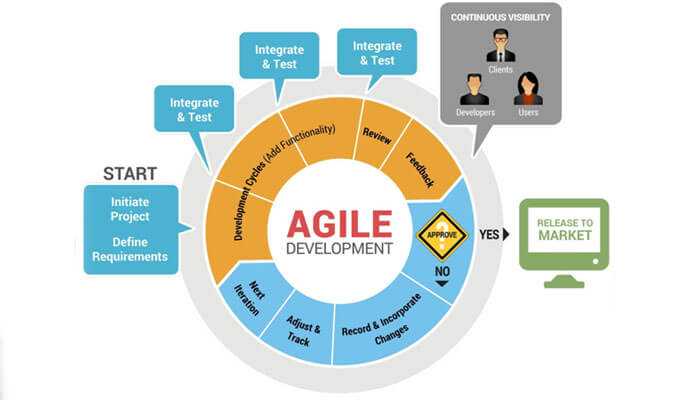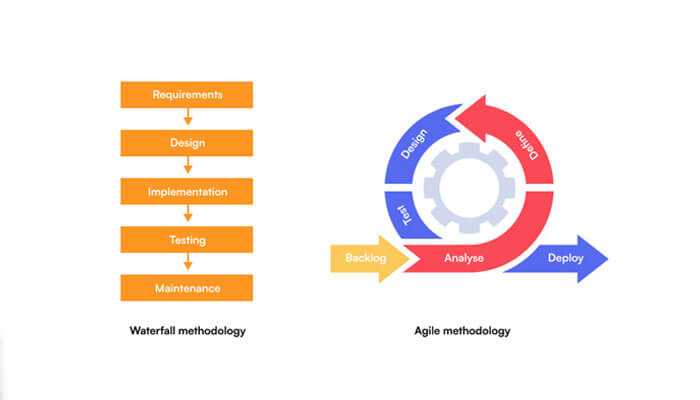Agile methodologies, in essence, is a flexible and iterative approach to software development, emphasizing collaboration, adaptability, and customer feedback. Its popularity has surged in various fields, including dedicated software development, due to its ability to enhance project efficiency and responsiveness to changing requirements.
Delving into the roots of Agile, it emerged as a response to the shortcomings of traditional, rigid development methodologies. This article aims to provide a concise history of Agile’s evolution, outlining its fundamental principles and highlighting the specific advantages it brings to dedicated software development.
The Rise of Agile Methodologies
Agile methodologies have witnessed a remarkable ascent in software development, revolutionizing how projects are executed and managed. Back in 2018, 91% of survey participants reported the adoption of an agile development methodology within their organizations, and 88% affirmed implementing continuous integration practices.
The prominence of agile in software development reflects a broader industry acknowledgment of its efficacy in delivering high-quality, customer-centric solutions within the constraints of modern development landscapes.
A Brief History of Agile
Agile methodologies trace their roots to the early 2000s. They stem from a critical examination of the traditional Waterfall project management approach. Waterfall’s limitations, such as its inability to accommodate changes once the development process began and a lack of continuous customer involvement, laid the groundwork for the evolution towards Agile.
It’s essential to note that Agile doesn’t entirely replace Waterfall, as the latter still finds application in specific scenarios. For example, Waterfall may be more straightforward and efficient for small projects with well-defined requirements. However, Agile has become the preferred choice, especially in dedicated software development, fostering a culture of collaboration and adaptability that aligns seamlessly with the needs of modern projects and dedicated teams.
Why Agile is Gaining Popularity
Here are the problems posed by Waterfall Agile overcomes:
1. Flexibility gap. Waterfall’s rigid model hinders adaptability. Conversely, Agile’s flexibility is evident in its ability to seamlessly accommodate changes at any stage, aligning development with evolving requirements. For instance, a study by Standish Group found that projects using Agile were 28% more successful.
2. Long development cycles. Agile, with its iterative nature, promotes quicker deliverables.
3. Limited client interaction. Agile encourages continuous collaboration, ensuring clients remain engaged throughout the development journey.
4. Quality assurance timing. Agile integrates testing at every phase, reducing the likelihood of defects and ensuring a higher overall product quality. The State of Agile report indicates that 48% of organizations practicing Agile experienced improved product quality.
5. Rigidity in requirement changes. Agile, through iterative refinement, accommodates changing project needs.
6. Delayed feedback. Agile, with its iterative feedback loops, allows for continuous improvement throughout the development lifecycle.
7. Team motivation. Agile’s emphasis on visible progress in each iteration boosts team motivation. Up to 85% of respondents experienced improved team productivity after transitioning to Agile methodologies.
Key Principles of Agile Methodologies
Having grasped the essence of Agile methodology, let’s delve deeper into its foundational principles. This section will provide a detailed exploration of the core principles of Agile practices for effective and responsive software development.
Embracing Change
Unlike traditional methodologies that may resist alterations once a project is underway, Agile recognizes change as an inherent and valuable part of the software development journey. This approach enables teams to respond swiftly to changing requirements, even in the later stages of development. By emphasizing iterative cycles, Agile empowers teams to navigate uncertainties and deliver value iteratively, ensuring a more responsive and customer-centric development process. This iterative nature promotes a proactive approach to change management, enhancing overall project resilience.
Incremental Delivery
Incremental delivery in Agile involves breaking down a project into small, manageable parts, with each iteration delivering a functional piece of the overall solution. This approach allows for continuous improvement, flexibility, and a quicker response to changing requirements. Teams deliver a working product incrementally, providing tangible value at the end of each iteration.
This method enhances collaboration, adapts to evolving needs, and ensures the project remains aligned with stakeholder expectations throughout its development lifecycle.
Collaboration and Customer Involvement
In Agile methodologies, collaboration and customer involvement are paramount. Teams work closely, fostering constant communication and adaptability. This is accomplished through daily, concise meetings and stand-ups. In these sessions, the entire team assembles to review advancements, tackle potential challenges, and collaboratively strategize on the subsequent actions to be taken.
As with team collaboration, customer involvement is a pivotal Agile principle. Unlike traditional waterfall approaches, where clients participate mainly at the project’s outset and end, Agile integrates customers at every development stage.
The Role of Agile in Dedicated Software Development
Agile drives efficiency in dedicated software development, promoting collaboration and adaptability to swiftly respond to changing requirements and ensure quality results. In this context, we will delve into the specific role Agile benefits play in dedicated development and how they contribute to the success of this partnership:
1. Flexibility:
Agile’s adaptability caters to the ever-changing demands of dedicated teams, allowing swift adjustments to evolving requirements common in complex, ongoing projects.
2. Team collaboration:
Agile’s focus on people and interactions enhances team collaboration, a vital aspect for dedicated teams striving for heightened efficiency over extended durations of work.
3. Client interaction:
Close engagement with clients is integral to dedicated software development. Agile’s continuous client involvement complements the long-term commitment of dedicated teams, ensuring constant communication and alignment with project goals.
4. Transparency for clients:
Agile’s transparency mechanisms, like regular software demonstrations, provide clients with clear insights into project progress. This transparency fosters client confidence, enabling them to track the development journey.
5. Scalability:
As projects scale up or down, so does a dedicated team. Here, agile’s scalability becomes indispensable, so teams can adjust to project specifics. It efficiently accommodates the growing needs of projects without compromising efficiency.
Enhancing Communication and Collaboration
Within dedicated development teams, where the entire focus of developers centers on a singular project, collaboration stands as a linchpin. Daily standups within agile teams allow members to coordinate efforts, identify blockers, and ask for help from teammates.
Furthermore, the agile methodology emphasizes frequent communication and collaboration between the development team and stakeholders. Rather than only interacting at the beginning to gather requirements and at the end to view the finished product, stakeholders are involved throughout the iterative development process.
Boosting Productivity and Efficiency
Agile methodologies enhance productivity and efficiency by fostering collaboration, iterative development, and quick adaptability. Feedback loops, flexible planning, and a focus on customer needs contribute to streamlined workflows and improved outcomes.
Ensuring High Quality and Customer Satisfaction
Agile methodologies prioritize high-quality outcomes and customer satisfaction through iterative development, frequent testing, and continuous feedback. By embracing collaboration, adaptability, and regular customer engagement, Agile teams respond swiftly to changing requirements, delivering value in small increments.
Conclusion
Comprehending Agile methodologies is pivotal for dedicated software development teams aiming to thrive in the dynamic landscape. Agile is instrumental in enhancing project efficiency by embracing flexibility, iterative development, and client collaboration. As exemplified by industry leaders like Sigma. Software and agile methodologies foster adaptability and customer satisfaction.




